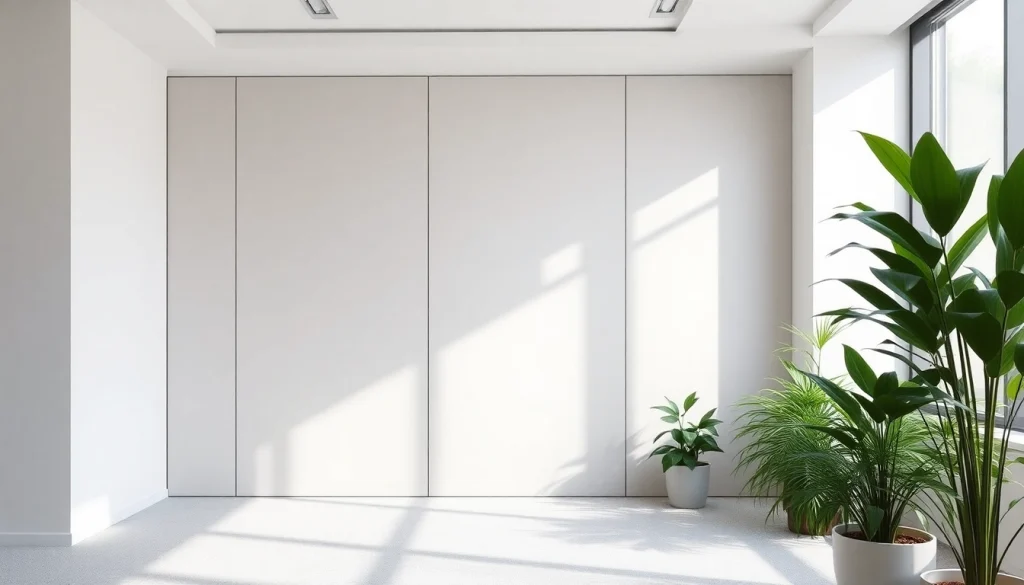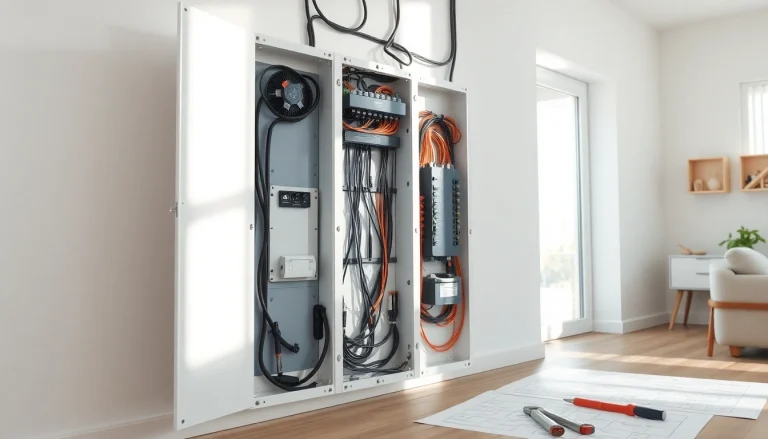
Understanding Folding Partition Walls
What are Folding Partition Walls?
Folding partition walls are versatile solutions designed to create flexible space in a variety of environments. These walls can be expanded or contracted based on the requirements of the space, functionally dividing an area while preserving an open feel when needed. Unlike traditional fixed walls, folding partition walls provide the advantage of reconfigurable spaces, making them an excellent choice for commercial settings, educational institutions, and homes. The walls typically consist of panels that are connected by a series of hinges or tracks, allowing them to be easily operated and moved aside when not in use.
In essence, a Folding Partition Wall serves as an adaptable element in architecture, fulfilling dynamic space management needs and enhancing functionality.
Different Types of Folding Partition Walls
Folding partition walls come in various configurations and materials, each tailored to specific functional and aesthetic requirements. Here are some of the primary types:
- Accordion Partitions: These are designed to fold back on themselves, similar to an accordion. They are often used in theatres and gymnasiums to quickly reconfigure space.
- Bi-fold Partitions: Bi-fold walls utilize hinges to allow two panels to fold inward. Ideal for smaller spaces, these partitions offer ease of use and can be made in custom sizes.
- Acoustic Partitions: Designed specifically for soundproofing, these folding walls contain specialized materials that minimize noise transmission, making them ideal for conference rooms and offices.
- Glass Folding Partitions: These partitions feature glass panels that allow natural light to permeate the space while still providing separation. They are popular in modern office designs for their aesthetic appeal and ability to maintain an open atmosphere.
How Folding Partition Walls Work
Folding partition walls operate through a system of tracks, rollers, and hinges. The panels are made to slide along the track, and users can push or pull the panels to create openings or separations based on their needs. Depending on the design, some walls can be easily moved by hand, while others may come equipped with mechanisms that automate the movement for added convenience.
Many folding partition systems can be configured to include additional functionalities, such as integrated electrical systems for lighting, display screens, or even built-in sound systems, enhancing their practicality and attractiveness in multifunctional spaces.
Benefits of Folding Partition Walls
Space Optimization in Commercial Environments
One of the primary advantages of folding partition walls is their ability to optimize space. In commercial environments, where real estate is often at a premium, these walls allow for quick adjustments to the configuration of spaces to meet changing needs.
For instance, a conference hall can be divided into smaller meeting rooms, facilitating multiple events simultaneously. Similarly, in educational institutions, classrooms can be divided or combined as needed, promoting collaborative learning without permanent structural changes.
Enhancing Acoustics and Privacy
Folding partition walls can significantly improve acoustic performance in shared spaces. Acoustic panels dampen sound, providing an environment conducive to focused work or discussion. This is particularly crucial in offices and schools, where distractions can impact productivity and learning outcomes.
Moreover, the ability to create private spaces on-demand enhances privacy for sensitive conversations and confidential meetings. The flexibility of these walls ensures that organizations can maintain a professional atmosphere without the limitations of fixed structures.
Cost-Effectiveness and Installation Benefits
Folding partition walls are often more cost-effective than constructing permanent walls. With reduced labor and material costs, businesses can repurpose existing spaces at a fraction of the cost of remodeling. Installation processes are quick compared to traditional wall construction, often requiring no tedious permits or extensive renovations.
Additionally, since these systems can be reconfigured easily, businesses have the potential to adapt their spaces without incurring significant long-term investment or disruption to their operations.
Choosing the Right Folding Partition Wall
Factors to Consider for Your Space
When selecting a folding partition wall, several factors should be evaluated to ensure the right fit and functionality:
- Purpose: Define the main function of the partition wall. Is it primarily for dividing spaces, enhancing acoustics, or providing privacy?
- Space Size: Take precise measurements of the area where the partition will be installed to ensure it fits effectively within the given constraints.
- Aesthetics: Consider the existing design elements of the space. The partition should complement the overall visual appeal and ambiance.
- Flexibility: Assess how frequently the space needs to be reconfigured and select walls that can accommodate frequent changes easily.
Material Options and Their Advantages
Folding partition walls can be made from various materials, each offering distinct advantages:
- Wood: Provides a warm aesthetic and is durable, making it a popular choice for offices and residential areas.
- Metal: Often utilized for more modern settings; metal partitions are exceptionally durable and can support extensive configurations.
- Glass: Ideal for maximizing natural light, glass walls maintain openness while providing separation. They are often used in upscale office spaces.
- Fabric: Fabric-covered partitions can enhance acoustic performance while adding a soft touch to interiors. They are easy to clean and can be customized extensively.
Customization Features for Different Needs
Many manufacturers offer customization options for folding partition walls. This may include:
- Size: Custom sizes can be fabricated to fit non-standard spaces.
- Colors and Finishes: Choose from a variety of colors and finishes to align with your brand or interior design scheme.
- Functional Add-ons: Integrate features such as whiteboards, shelving, or electrical outlets to enhance functionality.
Installation and Maintenance Tips
Professional Installation vs DIY
While some businesses may consider a DIY approach for installing folding partition walls, professional installation is generally recommended. Experienced contractors are familiar with the intricacies of setup, ensuring proper alignment, track installation, and functionality. Professional installation can mitigate potential issues such as misalignment or structural weaknesses that could arise from improper handling.
However, for those with a DIY inclination, resources are available, including installation manuals and online tutorials, which provide insights into the proper assembly techniques. It is essential to prioritize safety and adhere to manufacturer guidelines regardless of the chosen installation route.
Maintenance Best Practices
To ensure the longevity and effectiveness of your folding partition walls, regular maintenance is essential. Here are some best practices:
- Cleaning: Keep the surfaces clean to avoid dirt buildup that could impact aesthetics and functionality.
- Inspections: Regularly inspect the tracks and hinges for wear or damage. Promptly address any identified issues to prevent further complications.
- Adjustments: Over time, adjustments may be needed to maintain optimal operation. Follow the manufacturer’s recommendations for adjusting components.
Common Issues and Solutions
While folding partition walls are generally reliable, users may encounter common issues, such as:
- Difficulty Moving Panels: Regular cleaning of the tracks and lubrication of moving parts can prevent this issue.
- Noise During Operation: Check for obstructions in the track. Adding felt pads to the panels may help dampen sound.
- Alignment Problems: Regular inspections can catch alignment issues early. If misalignment occurs, adjustments may be necessary.
Case Studies: Success with Folding Partition Walls
Commercial Use Cases
Many commercial enterprises have successfully integrated folding partition walls to enhance their operational efficiency. Consider the case of a large conference center that utilizes folding partitions to create breakout rooms from a single large hall for simultaneous events. This flexibility has allowed them to increase booking rates and accommodate diverse client needs. Comparative analysis pre- and post-installation indicated a 30% increase in utilization rates.
Residential Applications
In residential settings, homeowners have leveraged folding partition walls to create fluid living spaces. For instance, a modern apartment may utilize glass folding partitions to separate a home office from the living area. This not only provides privacy but allows natural light to continue flowing through the space, creating an airy and functional home. Feedback collected post-installation revealed high satisfaction ratings among residents for design versatility.
Future Trends in Folding Wall Solutions
As the demand for flexible spaces increases, the future of folding partition walls looks promising. Emerging trends include the incorporation of smart technology, such as automated systems that can adjust the partition based on occupancy or sound levels detected in the room. Enhanced acoustic solutions will also become more important, as privacy in open-plan environments gains greater significance. The continual evolution of materials and design will likely yield even more aesthetically pleasing options that align with modern architectural standards.






